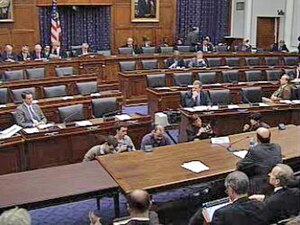 Image via Wikipedia
Image via WikipediaIt directly relates to the policies that are used to control money directly influence the behavior of the real estate market, including the increase or decrease in home values.
The mechanisms of money are controlled by two parties: the federal government and the Federal Reserve System.
" The Federal Reserve Bank controls the supply of money through a process called "monetary policy.
Fiscal policy is controlled by the federal government through the tax policy and government spending.
When the government lowers taxes, everyone has more money to spend on other items, such as new homes, personal goods, or business equipment.
This causes a general increase in prices due to the higher demand for fewer dollars.
If you receive a large tax refund every year, then you have more money to spend on items like TVs, computers, vacations, and food.
A small tax refund, or having to send the government a check due to higher taxes will cause you to spend less money on bills or consumer items.
In terms of the other method of influencing the economy, the amount of money the government spends can increase or decrease the supply of money in the economy.
Alternately, if the government decreases its spending on federal programs, then less government money enters the economy.
And if programs are cut or scaled back, employees are laid off and contracts are canceled for equipment, thereby decreasing the amount of money in the economy.
The effects of this fiscal policy techniques are felt indirectly by the economy as a whole and do not have the same level of impact as the monetary policy practiced by the Federal Reserve Bank.
The Fed, as it is commonly called, can control the supply of money in the economy directly by a number of different tactics.
If the Fed buys large numbers of these, then they exchange money for the securities, and more money is put into the economy when investors exchange their
Treasury Bills for money.
Investors trade their dollars for Treasury Bills, and the Fed holds onto the dollars, preventing them from going back into the economy to be used for other purposes.
When banks have to deposit a large amount with the Fed, then this money can not be used for additional loans for consumers or businesses.
If the Fed lowers the deposit requirement (known as the reserve requirement), then banks can use more of their money to extend credit to customers, and this money finds its way into the economy.
A final way that the Federal Reserve can control money is by directly raising or lowering the interest rate at which banks borrow money from the Fed.
If the Fed raises interest rates, then banks are less willing to borrow money and do not lend as much money, or lend money at higher rates.
The Fed directly influences the economy by controlling the total supply of money by creating or destroying money and determining the rate at which consumers can borrow money.
If home values decrease as a result of higher interest rates, or a recession in the economy, then homeowners in foreclosure may find that they owe more on their homes than the current value.
Thankfully, the economy operates in cycles of increasing and decreasing values, with a general optimistic trend.
Of course, this is only small consolation for foreclosure victims who would benefit from higher home values in the short term.
It is meant to give homeowners a bit of information regarding the broader economic context of their fight to stop foreclosure.
Knowing that the economy operates in cycles that are affected by these two entities can help homeowners realize that a foreclosure season in the economy is just like any other season: it comes periodically, may have extreme conditions, but will eventually pass into a different phase leaving only memories.

No comments:
Post a Comment